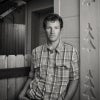Searching for Hurricane Matthew
As the Category Four storm threatened landfall last week, dozens of Urban Search and Rescue teams were deploying from around the country, mobilizing at lightning speed to save residents from the wreckage. Our man embedded with one of these elite squads—and soon learned the logistical nightmare involved with disaster aid on a massive scale.
New perk: Easily find new routes and hidden gems, upcoming running events, and more near you. Your weekly Local Running Newsletter has everything you need to lace up! .
On October 6, shortly before President Obama declared a state of emergency for Florida, Georgia, and both Carolinas, Rick Roatch’s phone vibrated. “Virginia Task Force One has been mobilized as a Type One USAR Team. All available personnel are to report to the USAR warehouse immediately.”
Roatch is a deputy fire chief for Virginia’s Fairfax County and the leader of Virginia Task Force One, 280 professional first responders who are deployed to disaster zones as an Urban Search and Rescue Team (USAR). At the same time his team received its orders, pagers were buzzing in the pockets of 775 other urban search and rescue team members from Washington State to New Jersey. Hurricane Matthew, a Category Four storm which had just killed at least 800 people in Haiti, was threatening landfall along the length of the Southeast. It would be the strongest storm to hit the U.S. in ten years. The USARs had work, if they could get there in time.
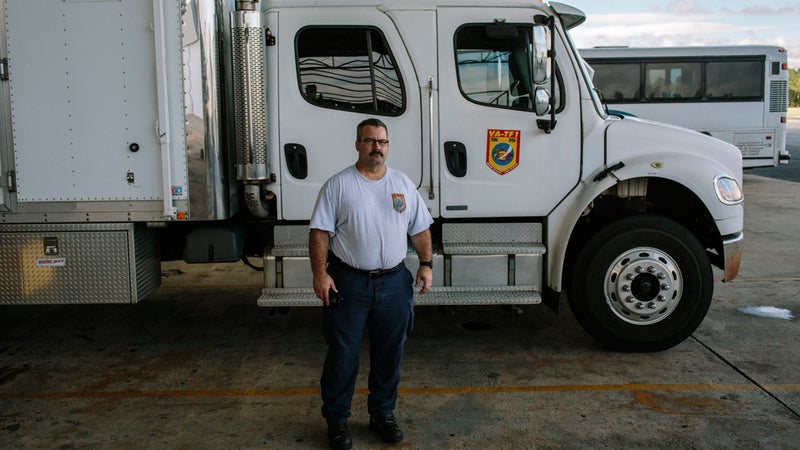
Over the next four hours Roatch and a total of seventy-nine paramedics, doctors, structural engineers, swift-water rescuers, K-9, and rescue specialists best suited for the mission assembled at Virginia Task Force One’s equipment warehouse in Chantilly, just outside of D.C. Each member handed their passport to a team officer in case they were needed internationally, then had their blood pressure and immunization records checked for fitness by a team doctor. All Roatch or any of them knew is, “You’re going to Florida,” and “there's going to be water.”
I didn’t hear of their deployment until that afternoon, but I’d been waiting for days. I’ve been working on a story about USARs for �����ԹϺ��� since the summer, and have spent too many hours stalking hurricane forecasts from the excellent climate journalist Eric Holthaus and his Twitter followers, looking for a cue that USARs might be deployed. Depending on a storm’s severity and how quickly a USAR request can run through the bureaucratic gauntlet that is disaster response, FEMA sends these teams of professional first responders, which come in sizes ranging from 42-to-80 personnel, in the hours before or just after man-made or natural disasters occur. There are 28 federal USAR teams nationwide.
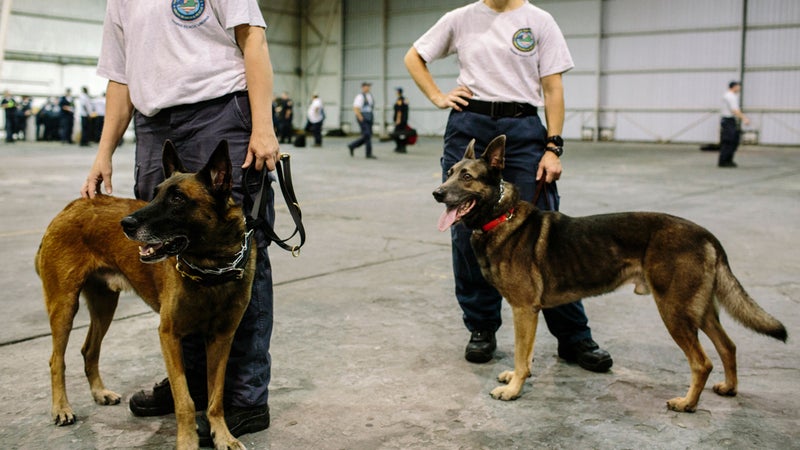
Virginia Task Force One had last deployed nearly a year ago, to Columbia, South Carolina, where they used boats to shuttle structural engineers to bridges that flooding had pushed to collapse. But often they’re work is a lot more dramatic. Since 2000, they’ve responded to the Pentagon during 9/11, Hurricane Katrina, both the Haiti and Nepal earthquakes, the Philippines, and Japan’s tsunami. They flew a C-17 to Nepal, where they used finely calibrated sounding equipment—a person scratching on metal sounds different than concrete or wood—to find a nine-year-old boy who had been buried beneath the rubble for three days. He survived in a collapsed kitchen by eating butter. In 2010, they landed in Haiti within twenty-four hours of the earthquake, and were escorted between collapsed building by armed U.S. Air Force PJs.
To see how the teams operate in the midst of a hurricane, I caught a last-minute flight to Atlanta, the closest operational airport to the storm's eye, and met up with photographer Will Widmer. Overnight, the city had become a refuge for many of the 2.5 million people under mandatory evacuation orders. For us, it would be the jumping off point. Spending the next several days chasing Matthew and USAR teams across the Southeast, we’d get an inside look at the enormous challenges involved with mobilizing professional rescue teams in advance of a shifting storm.
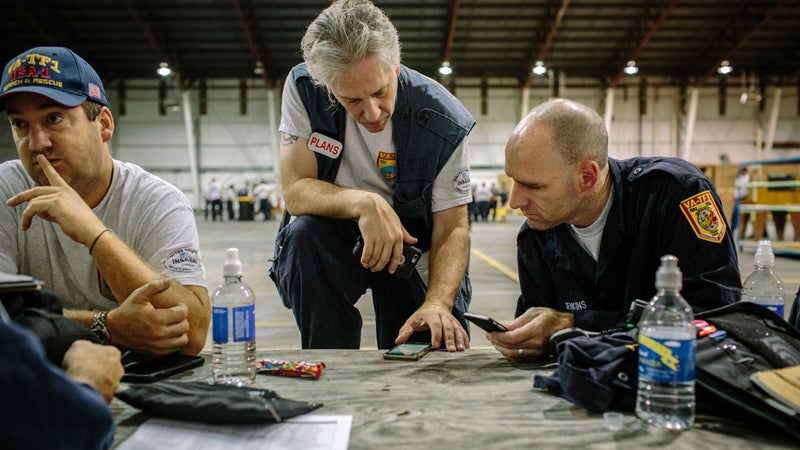
We pulled into the regional airport in Lake City, Florida, a freeway town four hours south of Atlanta, on the evening of October 7. FEMA’s southeastern region, which included Florida, Georgia, and the Carolinas, had positioned ten USAR teams near the four states and nearly 10,000 miles of coastline that Matthew threatened. Virginia Task Force One and three other teams were in Lake City for its proximity to Jacksonville, the biggest city in the storm's path. They’d driven thirteen hours through the night and were now waiting out the hurricane in a corrugated steel hanger big enough to hold a 747.
A big man with a walrus mustache and salt-and-pepper hair, Roatch stepped from the hangar to greet us in a stress-free Virginian drawl. Overhead, clouds spun eerily to the southeast and the corrugated steel awning we were under quaked like it was considering taking flight. “Before a storm makes landfall, we operate under the assumption that anywhere in the storm's track is going to be bad,” he said.
At the moment, 120-mile-an-hour winds were pulling a roof off a hotel in Daytona Beach, and the Atlantic was sluicing through Jacksonville’s beach-side alleys. Eight hundred thousand people in Florida were without power already. The National Hurricane Center had downgraded Matthew to a Category 3, but six-to-eight foot storm surge, what one member who had worked in post-tsunami Japan described as “the most powerful force on earth,” was predicted in Jacksonville. Their forecast echoed the doom in the hours before Katrina made landfall—“areas may be uninhabitable for weeks or months.” Florida Governor Rick Scott was holding regular press conferences to alert residents of the “very dangerous and life-threatening storm,” and Obama was pleading with Floridians to heed the evacuation orders.
The USARs were there for those who didn’t. The international teams were created in the late-eighties after a string of earthquakes in Mexico City, the Philippines, and Armenia, and domestically after 1989’s Loma Prieta earthquake. Realizing that all disaster responses are locally driven and most local departments lack the resources to provide the suite of technical skills large-scale disasters demand, FEMA created the USAR teams to function as surge capacity. A full eighty-person Task Force costs around $125,000 a day whether the team is searching, rescuing, or simply standing by. Nobody on Virginia Task Force One seemed to think the latter would happen in Florida. In a small fleet of pickups and four semis, Roatch had brought eight boats and 87,000 pounds worth of life-saving equipment, all of it pre-packaged so the team could fly anywhere in the world within six hours of a disaster.
“We don’t want the people of Jacksonville to get jacked up, but if mother nature puts that on them, we want to be there to help,” Roatch said. He's been a firefighter for twenty-six years and on the USAR team for twenty.
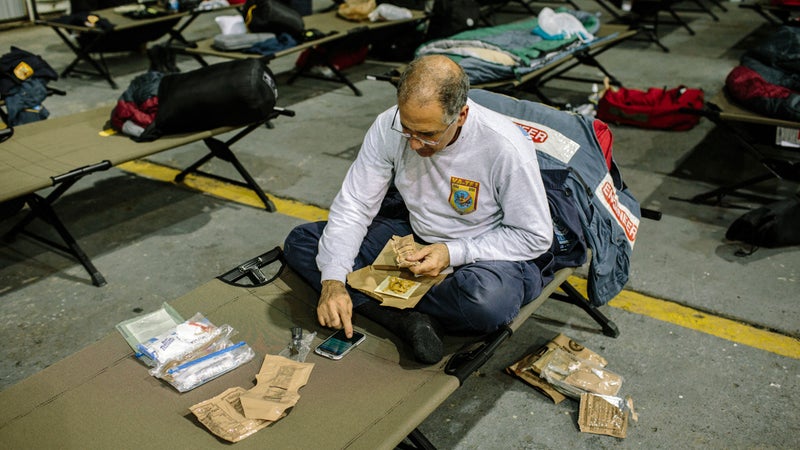
Inside the hangar, 160 men and women—young and middle aged, slim, muscled, overweight, black, white, Latino, and most all full-time firefighters—had set up a grid of cots beneath enormous halogen lights and were killing time. Some read alone, others stood in clutches of five-to-six people trading stories of previous deployments or trying to divine tomorrow’s actions from Jim Cantore's wet-jacket Weather Channel forecasts. The mood was tense like a pre-game locker room, minus the Donald-Trump jokes now dominating the news cycle.
By 10 p.m., the lights dimmed, and I took to doing what I assume everybody else in the hangar was doing: worrying about a several ton hanger wall being blown off and hoping perversely that the clanging steel promised work.
Virginia Task Force One was up at five a.m. the next morning. Within fifteen minutes the 160 cots were loaded back into the trucks and both teams ready to go. Men and women in black combat boots and blue Kevlar twill pants tore into Meals Ready to Eat and washed down the preserved foods with Mountain Dews bought at the still-operational vending machine. Mostly, though, they waited. Last night, Matthew had tracked the coastline, breaking high tide records in Fernandina Beach, Florida, and Red Bay Point, and carving a new inlet into the beach north of Marineland, but the urban centers had largely been spared. Matthew was now churning north through Savannah and toward the Carolinas, leaving Florida in its wake and shrinking the potential disaster zone by one very big state.
Roatch found an empty table in the hanger. While he waited for word of a new assignment, he played with his two iPhones, trying to figure out how to change his home thermostat because his wife was cold. “What’s the stupid password?” he groused. Every few moments, another member came up and asked him for an update—What’s up Chief? What's the word?
“Dude, we got nothing,” or “You’re looking at it,” he’d respond, showing not the least bit of irritation. “We've got 80 people who are basically attack dogs on a leash, they wanna help,” he said.
Ryland Kendrick, a senior firefighter for Fairfax County, at the picnic table next to Roatch, explained that a USAR operation is a lot like working for the fire department at home—sitting, waiting, training for something that might happen or might not. “They call it a disaster because it’s a disaster,” he said. “Everybody is trying to get a handle on things but things are changing all the time.” A bright and nervous guy, Kendrick then stood to pace. “It's all about being in the exact right place at the exact right time.”
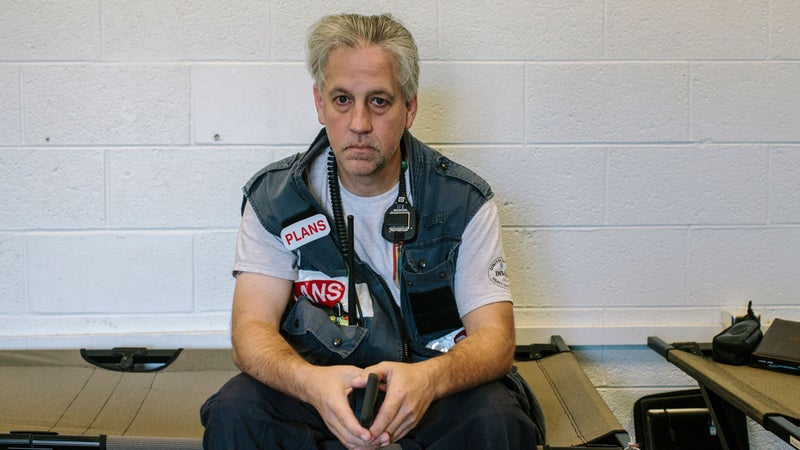
While Roatch and his team waited to receive their orders, Will and I left, hoping to meet up with another USAR, this one positioned in Charleston, South Carolina, where the National Hurricane Center was now predicting Matthew’s worst: more than a foot of rain and a historic flooding event. About an hour north on the coastal I-95, it was clear that Matthew had already blocked our route. Police were manning checkpoints at exits and off-ramps, and live oak trees, knocked over by 90-mile-per-hour winds, were strewn across the freeway. We took the median, driving on the rumble strip until Hardeeville, a highway town north of Savannah. There, I-95 was simply shut down. With no electricity, so were gas stations and restaurants. �����ԹϺ���, stranded motorists leaned against gas pumps while a man in a Mercedes drove back and forth in search of an escape inland. Every road to the east was blocked by fallen trees. “I’ve got a 95-year old mom and a 90-year-old dad in there,” he said, pointing to a hotel, “and all we’ve got is a box of saltines and a few bottles of water.”
A little after noon, we received word that Florida had released Virginia Task Force One. Georgia ordered Roatch and four other USAR task forces to deploy to Hunter Army Base in downtown Savannah, which sits between two rivers on a peninsula of swamp. Matthew's eye had passed within twenty miles of town. Will and I opted to head back south to meet them.
Along the route, the damage was extensive. At a crematorium in Port Wentworth, a riverside village west of the Savannah, a man driving a golf cart with a Jack Russell terrier leashed to the front seat drove up and stared at the red bricks and cinder blocks piled at the building’s foot. “Oh my Gawd,” he said. “That’s been here since I was kid—45 years.”
Farther down the road, we met Shantea and Malcolm Craig, a couple in their thirties whose red sedan had been crushed by a snapped pine that would have been at home in Sequoia National Park. “Ain’t that some shit there,” their neighbor said. They’d live in the house for a week, having just moved from Columbia, South Carolina, after being devastated by last year's floods. Malcolm walked to the fallen tree and ran his hand along the splinters sticking from the trunk. The tree was six feet from their bedroom, where he, his wife, and daughter were huddled when it creaked, groaned, then crushed their car’s engine block. “Moving from a flood to a hurricane,” Malcolm said, trailing off. Shantea couldn’t take this. She'd been smiling, grateful for the “guardian angel” that pushed the tree into something as replaceable as a car, but Malcolm's moment of candor cracked her smile into tears. “You work so hard for this stuff. You work so hard. This tree was not supposed to fall,” she said.
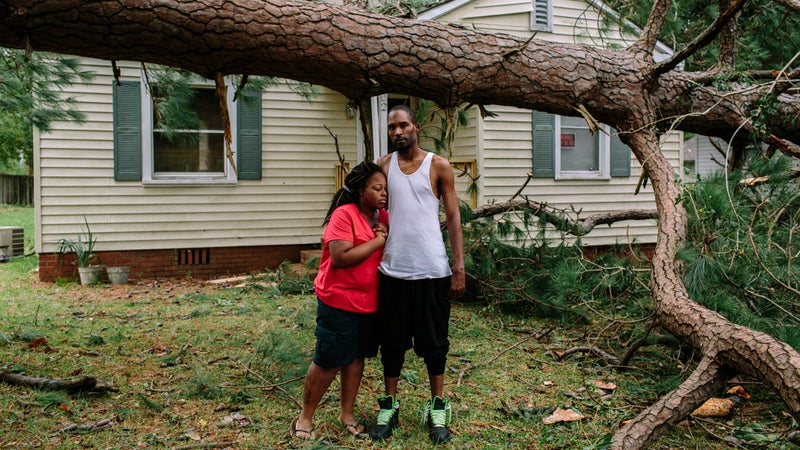
Leaving behind the Craigs, Will and I slipped through a police blockade set up to keep all but life-saving personnel out of downtown Savannah. Double-rotor Sikorsky helicopters passed overhead and convoys of National Guard humvees and troop carriers moved through the city. A curfew was in place—another Katrina echo. The National Guard was there to prevent looting by getting everybody off the streets by 7 p.m.. It took us hours to find an operational gas station, yet the city still felt busy with those who had refused to evacuate. Inside the Original, a bar with the Pabst Blue Ribbon and Tecate logos painted on the plywood hung over the windows, hipsters and old timers were drinking ice-chilled Pabst tall boys and telling stories of last night’s storm. “This is the real story,” a man named Jerome with two tear drop tattoos beneath his left eye told me. “Savannah, barely flinching.”
We met back up with Roatch and Virginia Task Force One’s at Hunter Air Force Base, where the team arrived at nearly 11 p.m.. Still unaware of the extent of the damage, Florida was understandably slow to release them and moving 87,000 pounds of gear, plus 80 people, takes time. Four other USAR teams were already at the base of operations, an army airfield compromised by fallen trees that had folded the barbwire fencing around it. The USAR team unloaded, joking about the still-novel havoc MREs wreak on untrained stomachs, while search dogs jumped from the bus and peed in the grass. Then Roatch’s number two in command called everybody together for a briefing.
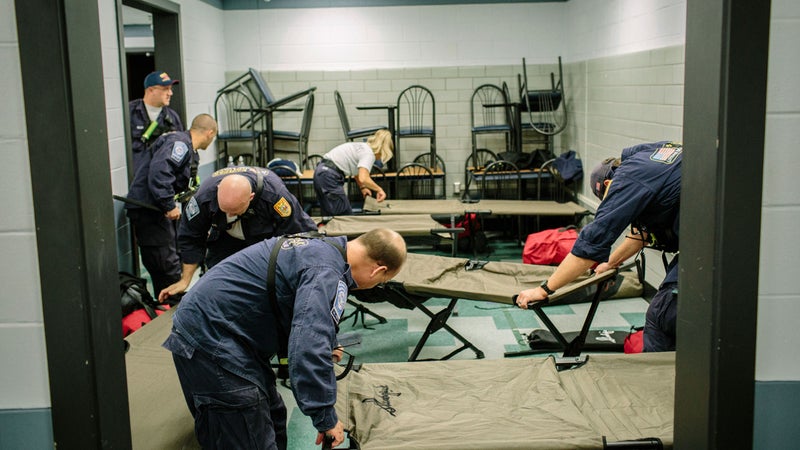
“Suddenly, there’s a lot of work out there,” he said, lit by floodlights. “There’s plenty of water to play in.” A New York-based USAR team rescued an SUV from the water nearby. “Good for them,” Roatch said, looking like a night of sleep could do him well. “Right place at the right time.” Apparently Tybee Island just east of Savannah was requesting help. Roatch’s team drew up a plan to send a recon team out first thing in the morning—boats, drones with cameras, swift water teams.
Meanwhile, the National Weather Service had downgraded Matthew to a Category One storm, but it was already well on its way to causing an estimated $6 billion in damages, the worst hurricane disaster since Sandy ravaged the northeast in 2012. Three million people would lose power, enough to render the blackout visible from space. After sweeping through Savannah, the storm spilled 13.6 trillion gallons of rain onto the Southeast, roughly 75 percent of the water in Chesapeake Bay. In North Carolina, the hurricane’s diminished severity caught people off guard. The ongoing flooding became so severe that authorities used sonars to search for submerged cars and victims; 4,300 people were displaced and living in Red Cross shelters and so far 17 have died. The USAR teams to the north saw plenty of action. Federal teams would pull more than 700 people from the water; local and state teams would pull 2,000 more.
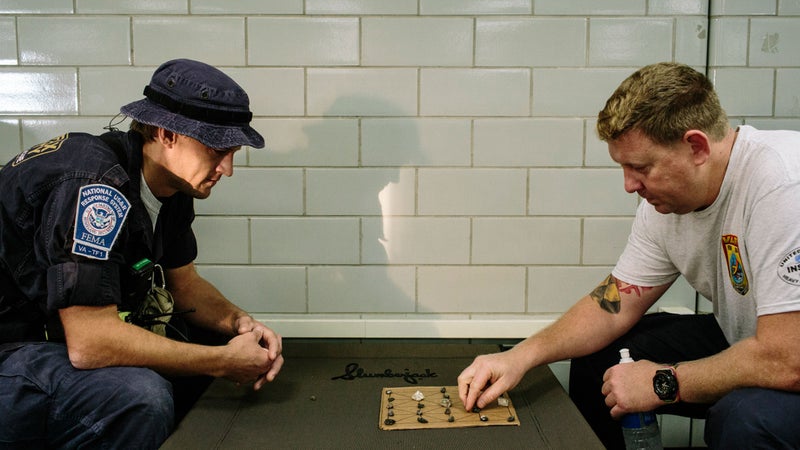
Virginia Task Force One, however, was still waiting to get involved. The team would move north to South Carolina's Fire Academy the next day, but they still wouldn't see any action. “More of what you saw,” Roatch told me days later.
In the morning, the recon team was slow to return, and men and women passed the time playing poker with Skittles on cots or stepping out for a morning jog. I waited with Kendrick, the senior firefighter, for news.
“We're here for a disaster, and this is the nicest day of the year,” he said, laughing. It was clear and cool like it hadn’t been all summer, and migrating geese flew overhead. Finally, word comes back from the recon team. Tybee took a bit of a beating, with torn down signs, roofs blown off, and forests toppled. “Yeah,” Kendrick said, not believing it. “I heard when the governor flew over, he saw residents mowing their lawns.”
Then, a few USAR members pour into the barracks shouting, “Briefing in two minutes! Briefing right now! Let's go! Let's go!” Everybody gathered outside by the trucks, and the anticipation was audible. Maybe there's work?
“The current plan is to do brunch at 10 a.m.”


